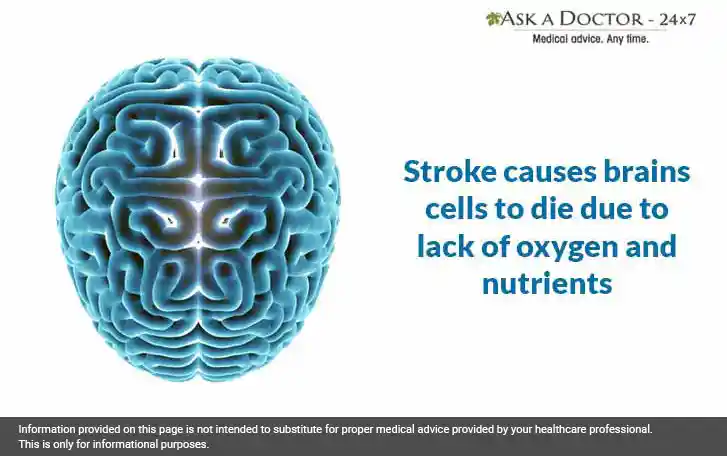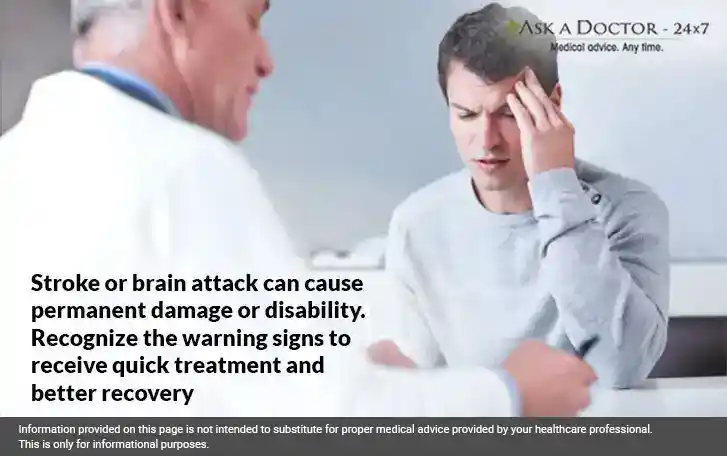Stroke: Risk Factors, Warning Signs, And Things You Can Do To Prevent A Stroke
Stroke is the second most common cause of death around the world and a severe cause of lifelong disability in many cases. When the blood flow to your brain is stopped, it results in a stroke or brain attack. Recognizing its risk factors and early warning signs can help avert the harsh consequences of this life-threatening disorder.
Read all about stroke in detail...
How Does a Stroke Occur?

Stroke occurs when the blood supply to a part of the brain is hindered or decreased. This may be due to a blockage in the blood vessels supplying the brain (ischemic stroke) or bursting of blood vessels (hemorrhagic stroke). This causes injury to that part of the brain and adversely affects the body parts controlled by it.
What are the Risk Factors for Stroke?
Anyone, at any age, can get a stroke. However, the chances of having a stroke increase if a person has certain risk factors associated with his/her poor lifestyle or any medical condition.
Some of the common comorbid risk factors for stroke that can be managed medically include:
- High blood pressure: Having a blood pressure of 140/90 or higher can damage blood vessels (arteries) that supply blood to the brain.
- Heart disease. It is the second most common risk factor for stroke and one of the major causes of death in stroke survivors. There are many similar risk factors associated with heart disease and stroke.
- Diabetes. If you are dealing with diabetes, you are at a greater risk for a stroke than someone who does not have diabetes.
- Smoking. Tobacco consumption in any form, especially smoking almost doubles your risk for an ischemic stroke.
- History of transient ischemic attacks. Often strokes are preceded by a ‘warning’ or a ‘mini’ stroke, termed as a transient ischemic attack (TIA). It has symptoms similar to that of stroke but doesn’t cause harm to the brain. If someone has had one or more TIAs, s/he is almost 10 times more likely to have a stroke than anyone who never had a TIA in the past.
- High red blood cell count. A significant increase in the number of red blood cells thickens the blood and makes clots more likely. This raises the risk of stroke.
- High blood cholesterol and lipid levels can contribute to the thickening or hardening of the arteries (atherosclerosis). This thickening occurs due to a buildup of plaque - a deposit of fatty substances, cholesterol, and calcium. When plaque builds up on the inside of the artery walls, it obstructs the amount flow of blood to the brain. Whenever the blood supply is cut off to the brain, even for a moment, it leads to a stroke.
- Atrial fibrillation or Abnormal heart rhythm is the most powerful and treatable heart risk factor of stroke. Atrial fibrillation leads to having an irregular heartbeat that can raise your risk for stroke, two-fold.
- Cardiac structural abnormalities or damaged heart valves (valvular heart disease) are known to cause long-term (chronic) heart damage. Over time, this can raise your risk for stroke.
Other lifestyle-related risk factors include:
- Obesity: Being overweight is one of the top ten risk factors for stroke and is associated with almost 1 in 5 strokes
- Excessive use of birth control pills (oral contraceptives), without the proper guidance of a certified doctor, doubles the chances of stroke, especially in ladies.
- Excessive alcohol use. More than 2 drinks per day raise your blood pressure. Binge drinking can lead to stroke.
- Illegal IV (intravenous) drug abuse carries a high risk of stroke from blood clots (cerebral embolisms). Cocaine and other drugs have been closely linked to strokes, heart attacks, and many other cardiovascular problems.
- Physical inactivity or lack of exercise. A sedentary lifestyle or being physically inactive leads to fatty material building up in your arteries (the blood vessels that carry blood to your organs). When the arteries get damaged and clogged, it can lead to a heart attack and stroke.
Besides the above, there are a few more risk factors for stroke that can’t be changed such as older age, gender, race, genetic disposition, prior history of stroke, etc.
6 Warning Signs of Stroke That Everyone Must Know

The warning signs of stroke may occur days or hours before a stroke actually occurs. Understanding these and reacting to them in the right way can prevent serious damage to the brain, permanent disability, or even death. DO NOT ignore these 6 tell-tale signs of an impending stroke:
1#. Numbness or weakness in face or limbs: One of the most common signs is the feeling of numbness or weakness in the face, arm, or leg. This is usually seen in one half of the body. This is because the brain has two hemispheres and each controls the opposite side of our body.
2#. Drooping face: One side of the face around the corner of your mouth may droop as a sign of an impending stroke. The smile too is drooped. The side of the face affected depends on the affected side of the brain. One may face difficulty in controlling facial expressions at this time.
3#. Slurred speech or difficulty understanding: Stroke impairs the brain’s ability to process words and one may experience difficulty in speaking. The patient also finds it difficult to understand what others are saying and may have trouble reading, comprehending, or writing.
4#. Troubled vision: A person’s vision may get blurred, as stroke sometimes tends to damage the controlling unit of the brain for this function. The person may have troubled vision in one or both eyes.
5#. Difficulty walking: A person may experience numbness and weakness in limbs and may feel dizzy, apart from losing his balance. A stroke may cause a lack of coordination and the person might face difficulty in getting up, walking, balancing, or staying upright.
6#. Sudden and severe headache: With no obvious cause, you may feel a sudden and sharp headache that doesn’t seem to be like the headache you usually get. This may occur in hemorrhagic stroke. A headache can sometimes be accompanied by dizziness or loss of consciousness.
The acronym ‘FAST’ sums up the quick and easy-to-learn warning signs:
F - Face drooping: When the person is asked to smile, the face droops to one side, and the smile looks uneven; this may occur along with numbness.
A-Arm weakness: The person may feel weakness in the arm. If he/she tries lifting the arm, the arm may drift downward.
S - Speech difficulty: The person may face difficulty in speaking, understanding, writing, or reading.
T - Time: If you notice the above signs, call emergency right away.
Things You Can Do To Reduce the Risk of Stroke
To protect yourself and the people you love, alongside recognizing these signs, you should work towards learning and reducing your risk factors. Set some healthy goals such as:
- Eat healthy, nutrient-enriched, low-fat foods. Eat plenty of fresh fruits and vegetables. Avoid trans fats.
- Exercise regularly. If you are recovering from a stroke, talk to your healthcare provider and rehabilitation team for a list of dos and don’ts.
- Maintain a healthy blood pressure. Avoid too much salt in the diet.
- Control your blood sugar levels, if you are a diabetic.
- Check your weight. Being overweight and obese increases the risk of developing severe health conditions.
- Quit smoking. Smoking is hazardous for your overall well-being
- Avoid alcohol. Too much alcohol triggers a rise in blood pressure and arrhythmias that can increase the risk of stroke. If you or your loved one has survived a stroke, even a small amount of alcohol can be dangerous.
- Follow up regularly with your healthcare provider. Ensure proper medical care if you or your loved one has suffered a stroke before or if they are at high risk of getting one. Take extra precautions if you have any underlying medical conditions that increase the risk of stroke. Ask a Cardiologist online to know more about stroke.
Stroke is a serious complication that needs immediate attention. DO NOT overlook the warning signs. Act FAST! Quick treatment can save one from disabilities and damage that may last a lifetime.
To know more about stroke and related concerns you can consult an online Cardiologist and get your queries resolved.
Recently Answered Questions Related to Stroke
Disclaimer: Information provided on this page is not intended to substitute for proper medical advice provided by your healthcare professional. This is only for informational purposes.
Ask a Specialist
Recent Questions


